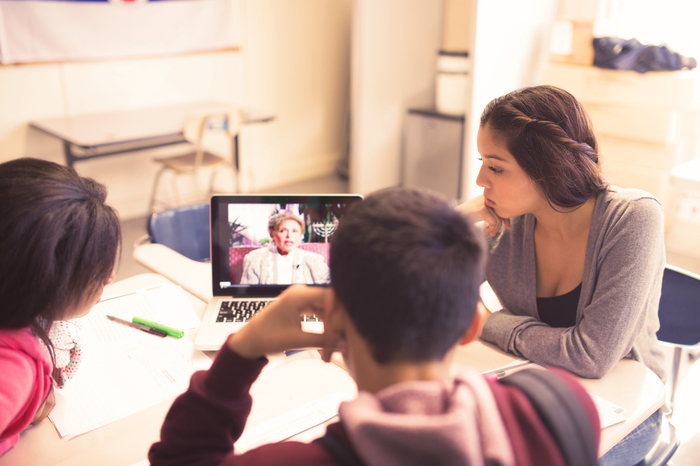
HOLOCAUST REMEMBRANCE
TEACHING

On January 27th, the anniversary of the allied liberation of Auschwitz-Birkenau, we commemorate International Holocaust Remembrance Day in honor of the victims of Nazi persecution. This annual observance provides an opportunity for teachers to focus on the pivotal role of liberators in defeating the Nazis at the culmination of World War II, and as some of the first to bear witness to the horrors of the Holocaust. Here are some strategies and resources to guide you in teaching about this topic:
Teach the Human Story: Survivor and Liberator Testimony
Eyewitness testimony highlights the human story behind the Holocaust and can help students further understand the importance of preserving one’s humanity during this dark period in history. Hearing from survivors on the paradoxical joy of liberation and darkness of facing a return to life without family, as well as from American soldiers who saw firsthand the horror of Nazi atrocities, offers an excellent entry point to the study of the Holocaust. Explore below:
Survivors
- Dennis Urstein: Born on February 24, 1924, in Vienna, Austria, he was incarcerated in the Buchenwald, Sachsenhausen, Ohrdruf, Auschwitz I, Mechelen, and Dachau concentration camps, and in Auschwitz-Birkenau extermination camp.
- Henry Mikols: Born on August 27, 1925, in Poznan, Poland. As a political prisoner, Henry was incarcerated in the Ellrich and Buchenwald concentration camps. From Buchenwald, Henry was sent on a death train to Bremen and then on to Bergen-Belsen, where he was eventually liberated.
- Ester Fiszgop: Born on January 14, 1929, in Brzesc nad Bugiem, Poland. She was forced to live in the Drohiczyn ghetto and later went into hiding in various places, including barns, forests, and attics.
Liberators
- Howard Cwick: Born on August 25,1923, in New York, NY. As a member of the United States Armed Forces, he, along with his fellow soldiers, liberated the Buchenwald concentration camp.
- Anton Mason: Born on April 19, 1927, in Sighet, Romania. He was forced to live in the Sighet ghetto and was later imprisoned in the Buchenwald, Gleiwitz, Auschwitz, Auschwitz I, and Auschwitz III-Monowitz concentration camps, as well as Auschwitz-Birkenau.
- Paul Parks: Born on May 7,1923, in Indianapolis, IN. As a member of the United States Armed Forces, he, along with his fellow soldiers, liberated the Dachau concentration camp.
In addition to oral testimony, written testimony is also a useful way to engage students in the human story of the Holocaust:
Our blog by Sheryl Ochayon, Echoes & Reflections Project Director at Yad Vashem, offers reflections on her interview with WWII liberator Alan Moskin and the importance of Holocaust remembrance.
You can also share written testimony from liberator Harry J. Herder, Jr., who was nineteen at the time he and other US soldiers liberated Buchenwald, in April 1945.
Teach through the Medium of Film
Explore our Video Toolbox, Liberators and Survivors: First Moments, on the liberation of concentration camps by the US Army at the end of WWII. This short film interweaves liberators’ and Jewish survivors’ testimonies and other primary sources, helping you present their personal stories to your students. Watch here
Engage Students with Multimedia Activities
Through our Partner USC Shoah Foundation’s IWitness, we bring the human stories of the Holocaust to secondary school teachers and their students via engaging multimedia-learning activities on the topic of liberation:
- New Beginnings-Journey to America
- Information Quest: Howard Cwick
- Understanding Displaced Persons’ Camp
Suggested Questions to Engage Students
1. How do you think survivors felt after learning they were liberated? What do you imagine some of their fears were?
2. What obstacles did survivors have to overcome following liberation?
3. What do you imagine were some of the thoughts and feelings liberators had after their experiences liberating the camps?
4. What is the effect of hearing both survivors and liberators talk about liberation? What kind of information do you learn from each?
5. What kind of information does the survivor provide that would be impossible to learn any other way?
Looking for more?
Our Unit on Survivors and Liberators contains all the resources mentioned in this piece as well as additional learning tools for exploration.
Deepen students' learning of liberation by viewing significant dates in history on our interactive Timeline of the Holocaust resource:




This site contains links to other sites. Echoes & Reflections is not responsible for the privacy practices or the content of such Web sites. This privacy statement applies solely to information collected by echoesandreflections.org.
We do not use this tool to collect or store your personal information, and it cannot be used to identify who you are. You can use the Google Analytics Opt-Out Browser Add-on to disable tracking by Google Analytics.
We currently do not use technology that responds to do-not-track signals from your browser.
Users may opt-out of receiving future mailings; see the choice/opt-out section below.
We use an outside shipping company to ship orders. These companies are contractually prohibited from retaining, sharing, storing or using personally identifiable information for any secondary purposes.
We may partner with third parties to provide specific services. When a user signs up for these services, we will share names, or other contact information that is necessary for the third party to provide these services.
These parties are contractually prohibited from using personally identifiable information except for the purpose of providing these services.
1. You can unsubscribe or change your e-mail preferences online by following the link at the bottom of any e-mail you receive from Echoes & Reflections via HubSpot.
2. You can notify us by email at info@echoesandreflections.org of your desire to be removed from our e-mail list or contributor mailing list.






 English
English